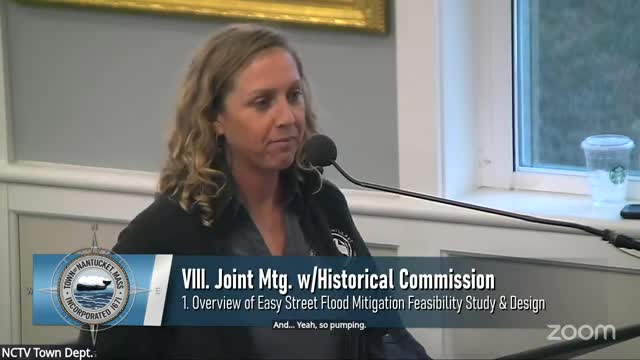Coastal resilience meeting explores road elevation and historical preservation challenges
January 02, 2025 | Nantucket County, Massachusetts
This article was created by AI summarizing key points discussed. AI makes mistakes, so for full details and context, please refer to the video of the full meeting. Please report any errors so we can fix them. Report an error »

The Nantucket Select Board meeting on March 12, 2025, highlighted pressing concerns regarding coastal resiliency and the impact of rising sea levels on the community. Board members engaged in a thoughtful discussion about the need for proactive measures to address flooding and infrastructure challenges that are already affecting residents.
One of the key topics was the necessity of raising roads and sidewalks to combat the increasing threat of flooding. Board members acknowledged that while the idea of significant changes to the landscape may seem daunting, it is essential for the long-term safety and accessibility of the area. The conversation emphasized the importance of public engagement in these discussions, as many residents may struggle to envision the changes needed to adapt to future conditions.
Members expressed a desire for visual examples from other regions that have successfully implemented similar infrastructure changes. This could help the community better understand the potential transformations and the rationale behind them. The board noted that while some areas, like Miami and New York, have begun to raise roads in response to flooding, Nantucket faces unique challenges due to its historic buildings and coastal geography.
The discussion also touched on the balance between preserving Nantucket's historic assets and ensuring the safety of its infrastructure. Board members recognized that any changes would dramatically alter the experience of navigating the town, particularly in areas with significant historical value. The need for a comprehensive approach that considers both the physical and cultural landscape was underscored.
As the meeting concluded, it was clear that the Select Board is committed to addressing these challenges head-on. They aim to develop a plan that not only protects the community from immediate threats but also preserves the unique character of Nantucket for future generations. The board's proactive stance reflects a growing recognition of the urgency surrounding climate change and its tangible impacts on local residents.
One of the key topics was the necessity of raising roads and sidewalks to combat the increasing threat of flooding. Board members acknowledged that while the idea of significant changes to the landscape may seem daunting, it is essential for the long-term safety and accessibility of the area. The conversation emphasized the importance of public engagement in these discussions, as many residents may struggle to envision the changes needed to adapt to future conditions.
Members expressed a desire for visual examples from other regions that have successfully implemented similar infrastructure changes. This could help the community better understand the potential transformations and the rationale behind them. The board noted that while some areas, like Miami and New York, have begun to raise roads in response to flooding, Nantucket faces unique challenges due to its historic buildings and coastal geography.
The discussion also touched on the balance between preserving Nantucket's historic assets and ensuring the safety of its infrastructure. Board members recognized that any changes would dramatically alter the experience of navigating the town, particularly in areas with significant historical value. The need for a comprehensive approach that considers both the physical and cultural landscape was underscored.
As the meeting concluded, it was clear that the Select Board is committed to addressing these challenges head-on. They aim to develop a plan that not only protects the community from immediate threats but also preserves the unique character of Nantucket for future generations. The board's proactive stance reflects a growing recognition of the urgency surrounding climate change and its tangible impacts on local residents.
View full meeting
This article is based on a recent meeting—watch the full video and explore the complete transcript for deeper insights into the discussion.
View full meeting
